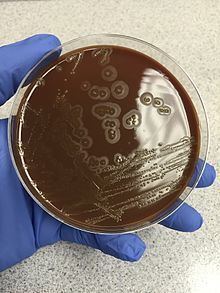Order Neisseriales Genus Eikenella Higher classification Eikenella | Phylum Proteobacteria Scientific name Eikenella corrodens Rank Species | |
 | ||
Similar Bacteria, Kingella kingae, Aggregatibacter actinomycetemcomitans, Capnocytophaga, Actinobacillus | ||
Eikenella corrodens
Eikenella corrodens is a fastidious Gram-negative facultative anaerobic bacillus. It was first identified by M. Eiken in 1958, who called it Bacteroides corrodens.
Contents
Eikenella corrodens
Microbiology
Eikenella corrodens is a pleomorphic bacillus that sometimes appears coccobacillary and typically creates a depression (or "pit") in the agar on which it is growing. Only half produce the pitting of the agar considered characteristic.
It grows in aerobic and anaerobic conditions, but requires an atmosphere enhanced by 3–10% carbon dioxide.
The colonies are small and greyish, they produce a greenish discoloration of the underlying agar, and smell faintly of bleach (hypochlorite).
They are oxidase-positive, catalase-negative, urease-negative, and indole-negative, and reduce nitrate to nitrite.
In 2006, Azakami et al reported that the periodontal pathogen E. corrodens have ortholog of luxS, the gene required for quorum sensing (QS) signal molecule AI-2 synthesis and E. corrodens can produce AI-2 signal for cell-to-cell communication and AI-2 has a role on biofilm formation by E. corrodens. Karim et al reported that this bacteria can produce AI-2 inactivation enzyme during its stationary phase. Karim et al also reported that LuxS-mediated QS may facilitate the maturation and detachment of biofilm formation in E.corrodens, which can leads to progression of periodontal disease.
Medical importance
Eikenella corrodens is a commensal of the human mouth and upper respiratory tract. It is an unusual cause of infection and when it is cultured, it is most usually found mixed with other organisms. Infections most commonly occur in patients with cancers of the head and neck, but it is also common in human bite infections, especially "reverse bite", "fight bite", or "clenched fist injuries". It also causes infections in insulin-dependent diabetics and intravenous drug users who lick their needles ("needle-licker's osteomyelitis"). It is one of the HACEK group of infections which are a cause of culture-negative endocarditis. In general, the HACEK organisms are responsible for approximately 3% of all cases of infective endocarditis (IE). IE due to E. corrodens is usually a result of poor oral hygiene and or periodontal infection. Manipulation of the gingival or oral mucosa for dental procedures also can predispose patients to infection since E. corrodens is a common constituent of the human oral flora.
Eikenella corrodens infections are typically indolent (the infection does not become clinically evident until a week or more after the injury). They also mimic anaerobic infection in being extremely foul-smelling.
Treatment
Eikenella corrodens can be treated with penicillins, cephalosporins, or tetracyclines. It is innately resistant to macrolides (e.g., erythromycin), clindamycin, and metronidazole. It is susceptible to fluoroquinolones (e.g., ciprofloxacin) in vitro, but no clinical evidence is available to advocate their use in these infections.
